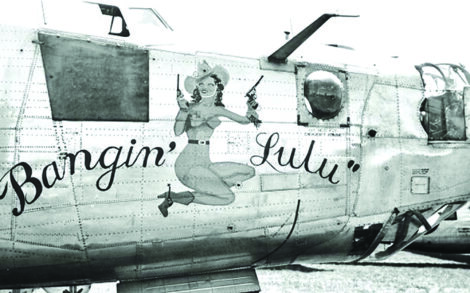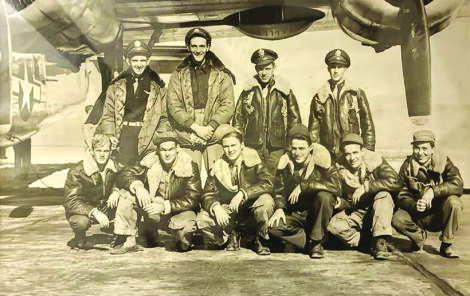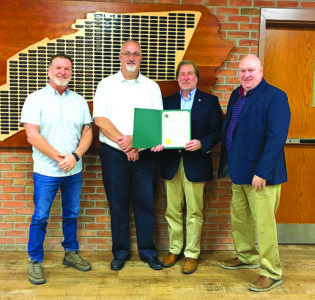The life and times of a B-24 Liberator
- Photo by Tony North. Used with permission B-24H ‘Bangin’ Lulu.’
- Photo courtesy of Walk family The crew of ‘Bangin’ Lulu,’ circa 1944 in England. Standing, from left, Robert Weideman (Pilot, Ohio), Jerome Joondeph (Co-Pilot, New York), Hector Petri (Navigator, Massachusetts) and Robert Taylor (Bombardier, unknown state of record); Kneeling, from left, Charles Mullen (Mechanic, Oregon), Cecil Walk (Radio Operator, Pennsylvania), Leonard Olson (Nose Gunner, South Dakota), Robert Morris (Armorer, Mississippi), Berrien Becks (Tail Gunner, Florida) and Donald Arrigoni (Waist Gunner, Pennsylvania).
- U.S. Air Force / Photo in the public domain B-24 from above showing the unique Davis wing.
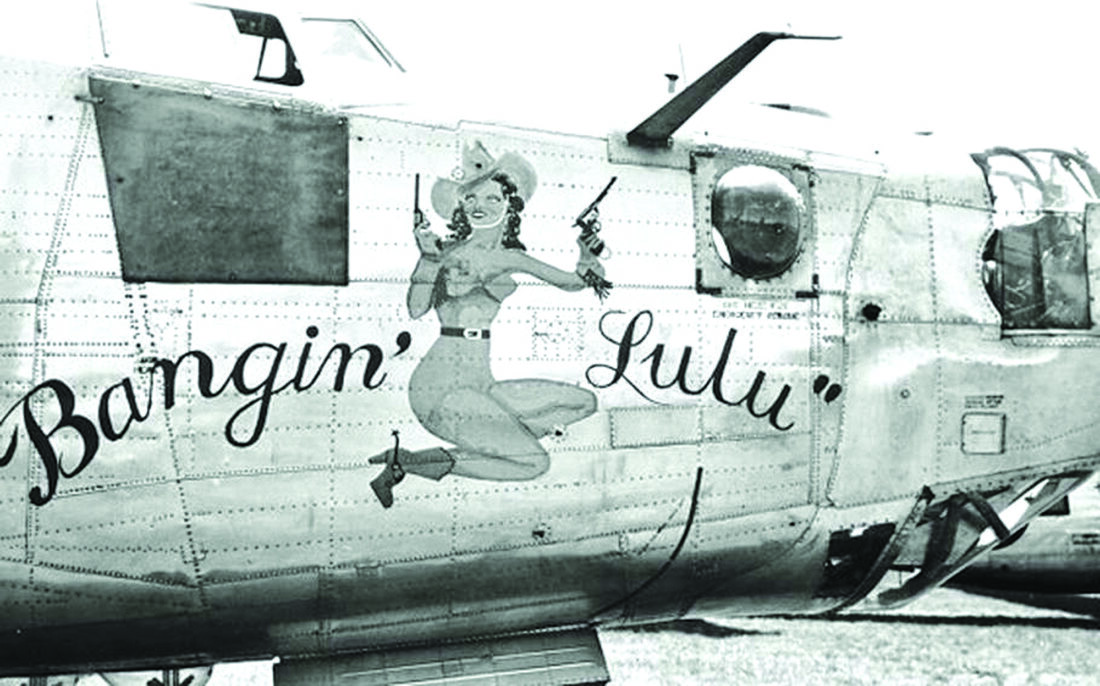
Photo by Tony North. Used with permission B-24H ‘Bangin’ Lulu.’
Editor’s Note: This article was previously published in the Oct. 17, 2025 edition of “Stars and Stripes.”
Several summers ago I was relaxing on our back porch in central Pennsylvania. I heard a very familiar rumble created by four massive radial engines. I heard that sound many times from old movies. I gazed skyward to see a B-17 slowly roar across a clear sky. The Commemorative Air Force was flying it back home after an air show. I was simultaneously astounded and thrilled to see a flying B-17. That engine noise was unmistakable.
The most well-known US heavy bombers in World War II were the B-17, B-24, and B-29. The Boeing B-29 “Superfortress” entered the conflict late in the war and has a unique place in military aviation history. The Boeing B-17 “Flying Fortress” is the most venerated heavy bomber from WWII and for good reason; it could take a pounding and still return to base. It was one tough airplane.
The B-24 “Liberator” was built by Consolidated Aircraft. It flew faster and carried a greater payload a further distance than the B-17. The unique Davis wing gave the B-24 the ability to cruise at a higher speed with a longer range compared to other bombers of the day. However, the B-24 had performance problems at slower speeds and was not easy to fly. Crews complained the airplane was difficult to maneuver, especially in formation. But the General Staff loved the B-24 and procured about 19,000 of them. It remains the most-produced heavy bomber in history and there were, amazingly, 21 B-24 Bomber Groups in Europe’s mighty 8th Air Force alone.
Wikipedia records that 13 Liberators currently survive with only one being a flyable aircraft and another being restored to flyable status. The other 11 are on display at various museums including the National Museum of the USAF at Wright-Patterson AFB, Dayton, Ohio. One B-24D (a Liberator named “Strawberry Bitch”) is located there. I still have a picture of it that I took in 1970. The lone flyable Liberator belongs to the Commemorative Air Force.

Photo courtesy of Walk family The crew of ‘Bangin’ Lulu,’ circa 1944 in England. Standing, from left, Robert Weideman (Pilot, Ohio), Jerome Joondeph (Co-Pilot, New York), Hector Petri (Navigator, Massachusetts) and Robert Taylor (Bombardier, unknown state of record); Kneeling, from left, Charles Mullen (Mechanic, Oregon), Cecil Walk (Radio Operator, Pennsylvania), Leonard Olson (Nose Gunner, South Dakota), Robert Morris (Armorer, Mississippi), Berrien Becks (Tail Gunner, Florida) and Donald Arrigoni (Waist Gunner, Pennsylvania).
The men (women were still restricted to non-combat roles) who flew bombers in WWII were, for the most part, young, patriotic, and wanted to “do their part for America.” We should remember their bravery and sacrifices; the 8th Air Force suffered over 47,000 casualties with more than 26,000 deaths. Seventeen 8th Air Force airmen won the Congressional Medal of Honor. Statistically, in WWII, serving in the infantry was safer than flying in the 8th Air Force.
This is an account about a special B-24. Its serial number was 42-51091 and the crew named her “Bangin’ Lulu.” Bangin’ Lulu was manufactured with a natural metal finish and was a B-24H. The improved H models had an electrically-powered nose turret directly above the bombardier that replaced the old “greenhouse” nose. The new turret was designed to fend off frontal attacks better.
Bangin’ Lulu was assigned to the 704th Bombardment Squadron (Heavy) at Flixton Field near the village of Bungay in Suffolk, about 90 miles northeast of London. The 704th, known as the “Bungay Buckaroos,” was part of the 446th Bombardment Group. A giant “H” fin flash painted on vertical stabilizers allowed crews to quickly identify 446th aircraft. The 446th was under the command of the 20th Combat Wing, 2nd Air Division, 8th Air Force.
Combat missions included sorties over Normandy, the Rhineland, Ardennes-Alsace, and central Europe. The 446th had an amazing record from 1943 to 1945 with over 7,000 sorties flown while only losing 58 aircraft.
The crew of Bangin’ Lulu flew 59 of those combat missions.
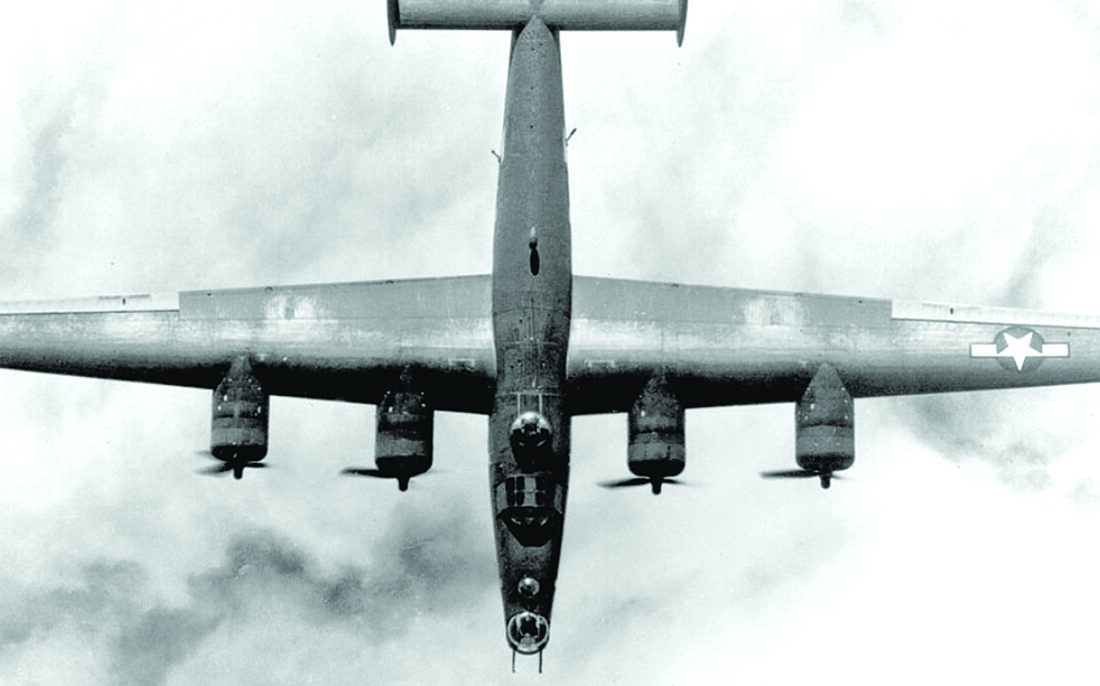
U.S. Air Force / Photo in the public domain B-24 from above showing the unique Davis wing.
Bangin’ Lulu survived the war and returned to the USA, first to Sioux Falls Army Airfield, South Dakota, then Carswell AFB, Texas, then finally to Ellington AFB, Texas. Like most B-24 Liberators, 42-51091 was scrapped after the war.
I have a special attachment to Liberator 42-51091. My father signed up with an Army Air Forces recruiter at his local church, went to radio and gunnery school in Yuma, and was Bangin’ Lulu’s radio operator. He flew 24 missions, earned an Air Medal, was mustered out as a TSgt at war’s end, and rarely talked about his wartime service.
He was only 20 years old.
Special thanks to the following whose collective information was priceless in researching the history of 42-51091:
• The Office of Air Force History and their publication, Combat Squadrons of the Air Force World War Two
• www.b24bestweb.com
• www.aviationmuseum.net
• www.americanair
museum.com
• https://commons.
wikimedia.org
•••
Joseph Walk is a military retiree. He and his wife, Nancy, reside in Belleville after serving twelve years stateside and eight years overseas.

